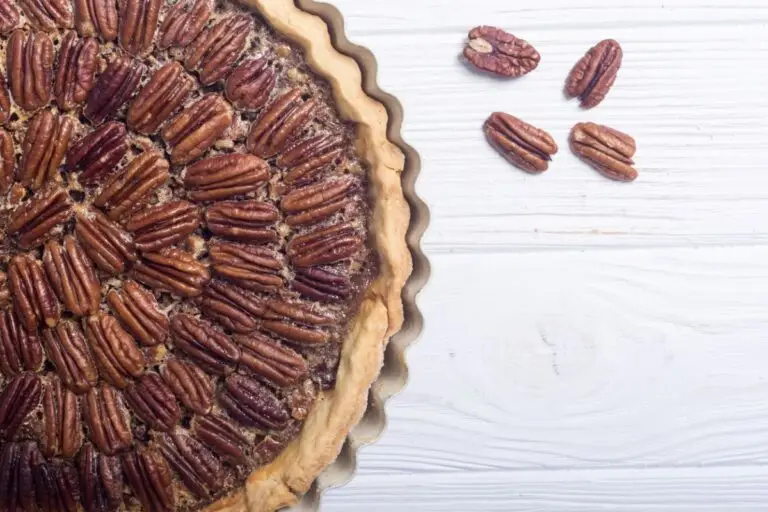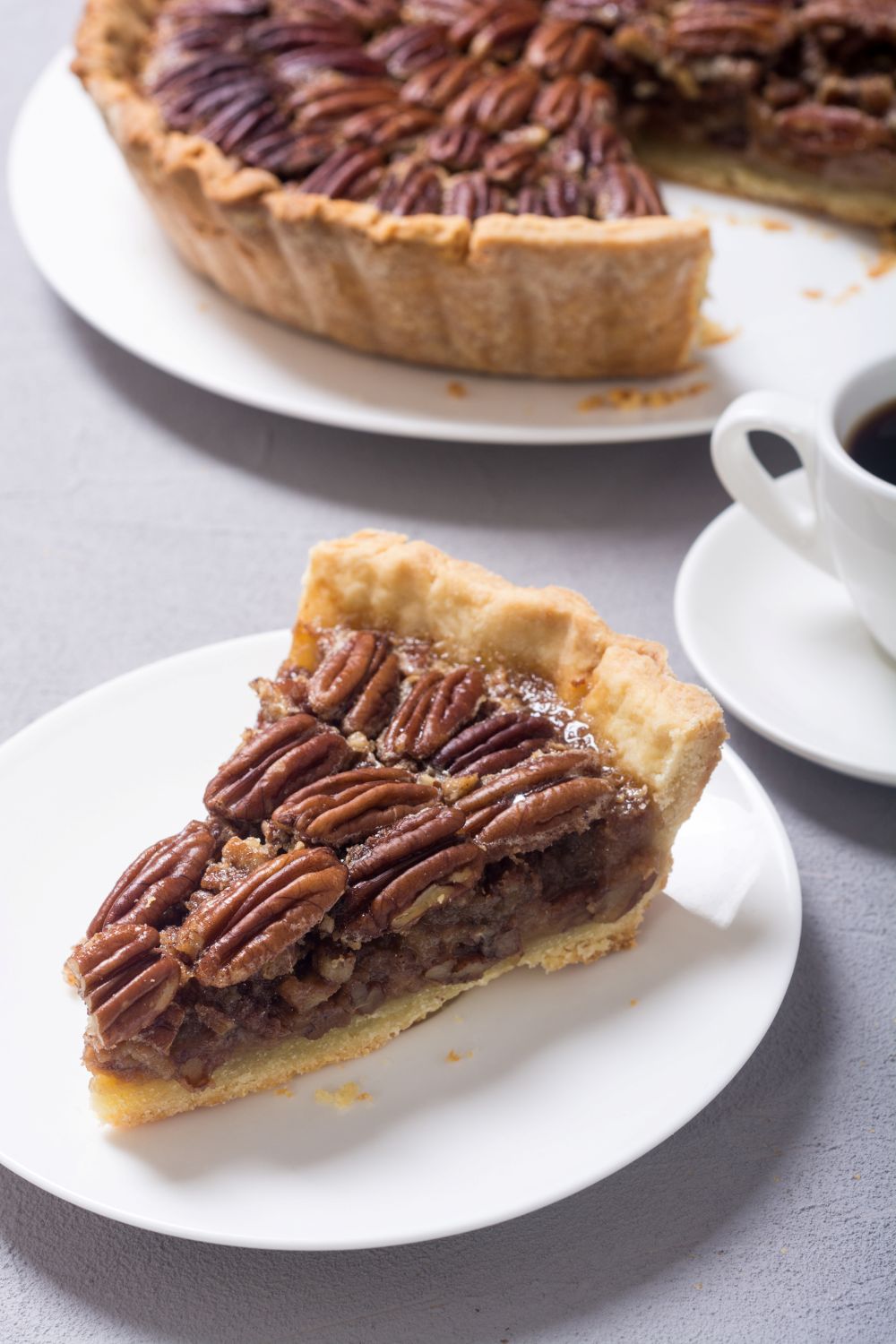This 1931 Depression-era pecan pie recipe yields a lighter, less-sweet custard filling that's easier to slice than modern versions. Made with Karo corn syrup, flour paste, and beaten egg whites, it won first place in a weekly recipe contest during hard times. The secret is in the flour-water paste that thickens the filling without heaviness, plus beaten egg whites that give it an almost soufflé-like texture. The result is a delicate pecan pie with a golden, nutmeg-kissed custard that sets perfectly and cuts into clean slices every time.
The crackle of pecans against your fork. The warm scent of cinnamon and nutmeg fills the kitchen. This is how Mrs. Chester Richmond won hearts (and prizes) back when a dollar for the best recipe meant something.

The 1931 Kitchen
When Mrs. Richmond submitted her winning recipe to The News, the Great Depression had already taken hold. Homemakers across America were stretching every ingredient, finding ways to create something sweet when sugar was precious and eggs were counted carefully. Radio shows like "Amos 'n' Andy" crackled through living rooms while women gathered in church basements, swapping recipes and survival strategies.
Pecan pie was experiencing its transformation in 1931. Karo corn syrup, introduced in 1902, had become a household staple, and by the late 1920s, the company was actively promoting pecan pie as a signature use for their product.
That very year, 1931, is when company lore claims a corporate executive's wife invented the famous "Karo Prize Pie" recipe. However, pecan pies using Karo had appeared in cookbooks as early as 1925. Mrs. Richmond's prize-winning recipe reflected this transitional moment, using Karo syrup as the base while adding her own special touches with flour thickening and beaten egg whites. Pie contests flourished even in hard times, offering cash prizes that could feed a family for a week.
What Makes This 1931 Pecan Pie Special

Depression Era Prize Winning Pecan Pie Recipe
This authentic 1931 prize-winning pecan pie features a lighter, custard-style filling made with Karo corn syrup, thickened with flour, and lightened with beaten egg whites; a Depression-era technique that creates a delicate texture unlike standard pecan pie recipes. The addition of warm spices and lemon juice produces a balanced, less-sweet pie that slices beautifully and showcases the pecans perfectly.
- Total Time: 60 minutes
- Yield: 8 slices 1x
Ingredients
- 2 cups Karo corn syrup (light or dark, though light was more common in 1931)
- Juice of 1 lemon (about 2-3 tablespoons)
- 2 tablespoons flour mixed with a little cold water (to make a smooth paste)
- 2 tablespoons melted butter
- 1.5 teaspoons nutmeg
- 1.5 teaspoons cinnamon
- 3 egg yolks (reserve whites)
- 1.5 cups granulated sugar
- 3 egg whites, beaten stiff with a little salt
- 1 cup pecans (for sprinkling on top)
Instructions
- Prepare the pastry shell: Line a 9-inch pie pan with your pastry crust and refrigerate while you make the filling.
- Prepare the flour paste: Mix 2 tablespoons flour with 2-3 tablespoons cold water until you have a smooth, lump-free paste. Set aside.
- Combine the base ingredients: In a large mixing bowl, add 2 cups of Karo corn syrup and the lemon juice.
- Add the flour paste and butter: Stir in the flour-water paste until well combined. Add the 2 tablespoons of melted butter and mix until thoroughly combined.
- Add spices: Mix in the nutmeg and cinnamon, stirring until evenly distributed.
- Beat the egg yolks with sugar: In a separate bowl, whisk the 3 egg yolks with 1.5 cups granulated sugar until the mixture is thick and pale yellow in color.
- Combine egg mixture with syrup base: Add the egg yolk-sugar mixture to the Karo syrup mixture and stir well.
- Beat the egg whites: In a clean, dry bowl, beat the 3 egg whites with a pinch of salt until stiff peaks form. They should stand straight up when you lift the beaters.
- Fold in egg whites: Gently fold the beaten egg whites into the filling mixture until just combined. Don’t overmix—you want to keep the air in the whites.
- Fill the pie shell: Pour the filling into your unbaked pastry shell.
- Add pecans: Sprinkle or arrange the 1 cup of pecans evenly over the top of the filling.
- Bake: Place in a slow oven (325°F) and bake for 35-45 minutes, or until the filling is set around the edges but still has a slight jiggle in the center.
- Cool completely: Remove from oven and let cool at room temperature for at least 3 hours before slicing. The filling will continue to set as it cools.
Notes
- Karo Syrup Choice: Light Karo syrup was more common in 1931 recipes and creates a lighter-colored filling. Dark Karo adds a deeper molasses flavor and was also popular during the Depression era.
- Toasting Pecans: For deeper flavor, toast the pecans at 350°F for 5-6 minutes before sprinkling on top.
- Testing Doneness: The pie is ready when the edges are set and puffed slightly, but the center still jiggles gently when you shake the pan.
- Prep Time: 20 mintues
- Cook Time: 40 minutes
- Category: Pies
- Method: Baked
- Cuisine: American, Southern
Nutrition
- Serving Size: 1 slice
- Calories: 471
- Sugar: 52.4g
- Fat: 13g
- Saturated Fat: 3.3g
- Carbohydrates: 85g
- Fiber: 1.6g
- Protein: 3.8g
How to Make Perfect Depression Era Pecan Pie
Recipe Variations, Serving Ideas, and Storage
Recipe Variations
Frequently Asked Questions
The flour paste needs to be completely smooth and well-mixed into the Karo syrup to activate the thickening. Also, make sure you beat the egg whites to stiff peaks and fold them in gently—they help the filling set as it bakes.
Light Karo syrup was more common in 1931 recipes and creates a lighter-colored, more delicate filling. Dark Karo (blue label in the 1930s) adds a deeper molasses-like flavor and was also popular during the Depression era. Both work well in this recipe.
Mrs. Richmond's original recipe doesn't call for blind baking, and the flour in the filling helps prevent a soggy bottom. However, if you prefer extra insurance, you can blind bake the crust for 10 minutes at 350°F before adding the filling.
The edges should be set and slightly puffed, while the center still has a gentle jiggle when you shake the pan. It will continue to set as it cools. If you overbake it, the filling becomes grainy.
A grainy texture usually means the pie was overbaked or the oven temperature was too high. The egg proteins bind too tightly when overcooked. Bake at 325°F and watch for that slight jiggle in the center.
Absolutely! This pie actually tastes better the day after baking as the flavors meld together. Make it up to 2 days in advance and store it covered at room temperature.
Mrs. Richmond's prize-winning version adds flour for thickening, uses beaten egg whites for a lighter texture, includes warm spices (nutmeg and cinnamon), and brightens the filling with lemon juice. The standard Karo Prize Pie recipe from 1931 was simpler; just Karo syrup, sugar, eggs, vanilla, and pecans.
The recipe already uses a balanced amount of sugar with the Karo syrup, but you could reduce the granulated sugar by 1/4 cup if you prefer a less sweet dessert. Keep in mind this will affect the filling's texture slightly.
Beating the egg whites separately and folding them in creates air pockets that give this pie its signature light, almost soufflé-like texture. It's what makes this Depression-era recipe special compared to the standard Karo Prize Pie that just whipped whole eggs into the filling.
Make sure to grease your pie pan well before adding the crust, or use a non-stick pie pan. If it's already baked and sticking, set the pan in hot water for 20-30 seconds to loosen the bottom without submerging the pie.
There's something quietly triumphant about a pie that won first prize when winning mattered most. What's the oldest recipe in your family that deserves to be remembered? If you make this 1931 Depression Era pecan pie, please leave a rating and review!





0 comments